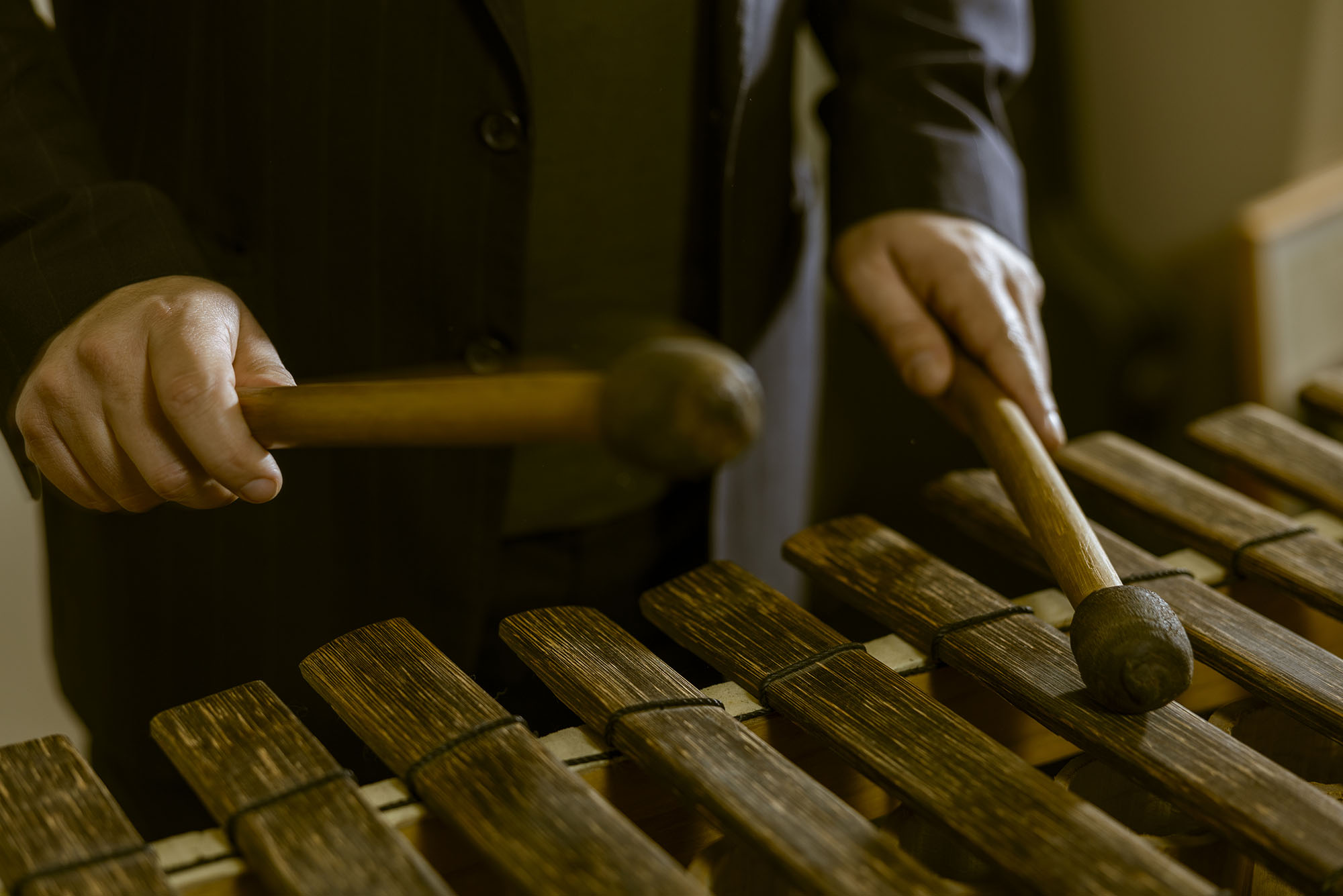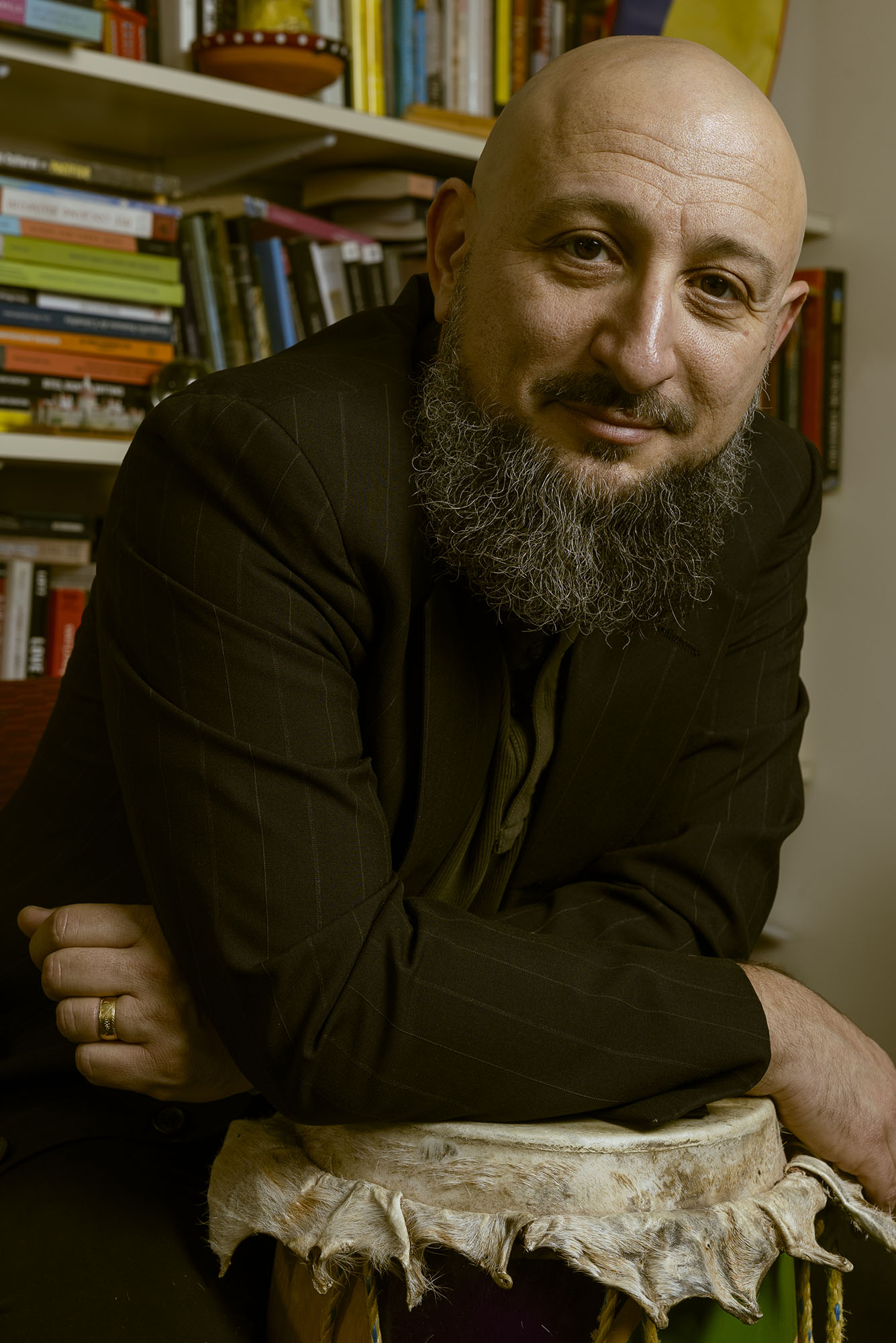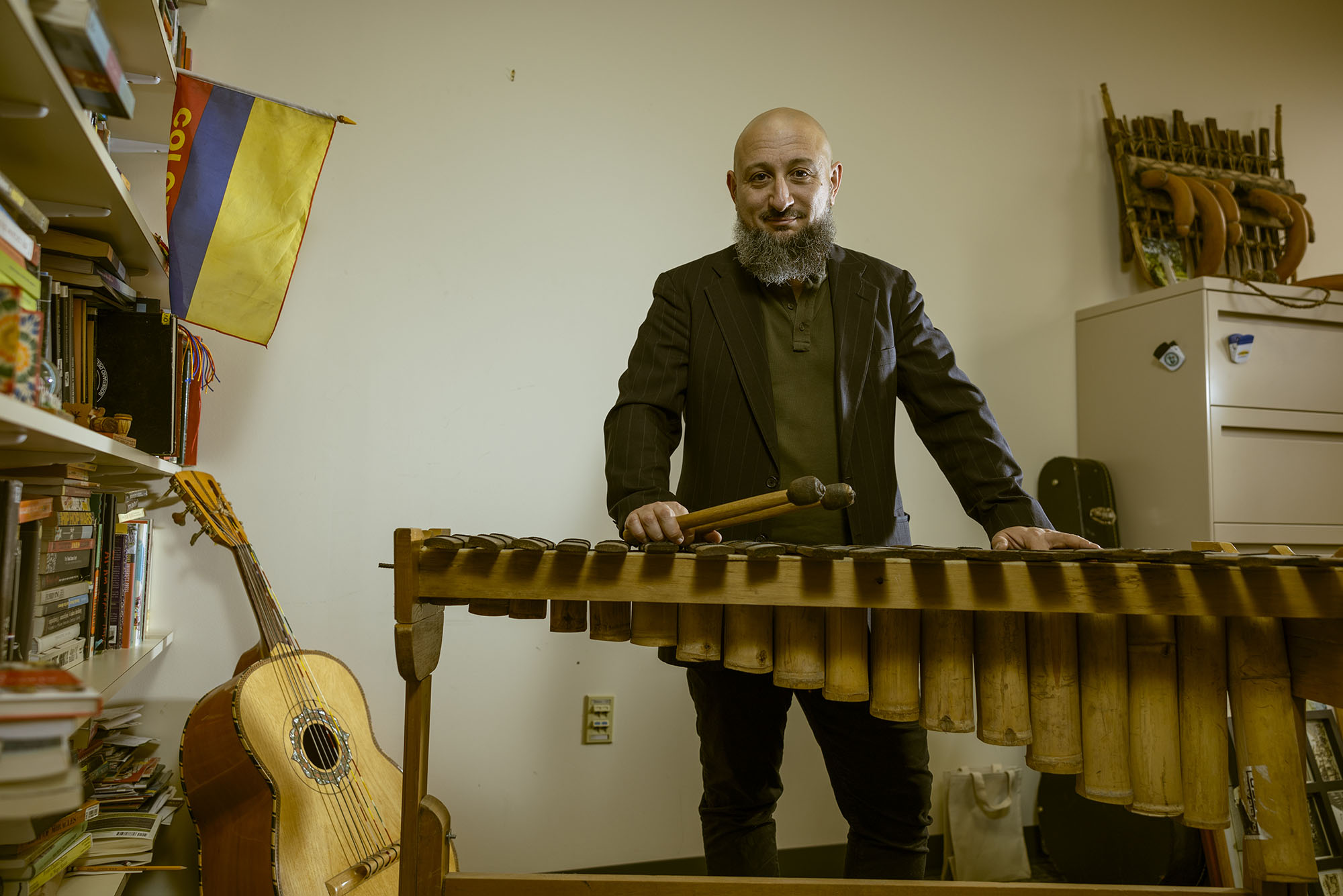Liberation through Rhythm: BU Ethnomusicologist Studies History and Present of African Beats
BU ethnomusicologist Michael Birenbaum Quintero studies African beats and their impacts in Colombia, Cuba, and the US

Liberation through Rhythm: BU Ethnomusicologist Studies History and Present of African Beats
Michael Birenbaum Quintero explores how African rhythms have influenced the cultures in Colombia, Cuba, and the US
Michael Birenbaum Quintero is Colombian American, but as a young man growing up in the States, he had little connection to his South American heritage. His way back into it was studying Colombia’s music.
“It was a way to find out things that I wanted to know about myself. And then I started finding out more about Colombia at large,” he says. “It’s a very fascinating, complex, tragic, beautiful, overwhelming place.”

An expert on how music intertwines with culture, Birenbaum Quintero is a Boston University College of Fine Arts associate professor of music and chair of musicology and ethnomusicology. His office at 808 Comm Ave is crowded both with the books and papers accruing from an academic career and the instruments of someone with a serious percussion habit, including an array of hand drums and shakers—and not one, but two marimbas.
His mother was Jewish and from the Bronx and his father had grown up outside Cali, Colombia. He was young when his parents split up and his father was deported back to Colombia, where he died. Growing up in New York City and New Jersey, Birenbaum Quintero missed a relationship with his father’s side of his heritage.
Music was a big part of his life from early on. He played guitar in high school, but switched to a tres, a Cuban guitar, and later to percussion when he started playing with salsa bands as an undergraduate in New York. “All of that music is built off interacting with [rhythm] patterns. And so I found myself exploring the percussion more and more,” he says.
Birenbaum Quintero was teaching ESL in New York City for a living when a chance encounter with an ethnomusicologist—a person who studies music in cultural contexts, including religion, politics, and the environment—started him on a career path in academia. Curiosity about his roots eventually led him from salsa in the direction of Colombian music.
“I was very interested in questions about race, questions of identity,” he says. “And I found there’s also a very interesting story about Black Colombians, about the political process, about the place of music and culture within the political process. So I just found all of that stuff really, really fascinating. And, you know, 21 years later, here I am.”
Music as “Liberation Technology”
Birenbaum Quintero started his academic career with a paper on champeta music, a danceable mash-up of Caribbean and African influences that developed mainly in Cartagena, a busy Caribbean port.
“Decades before world music became part of the music industry in the US and Europe,” he says, “working-class Afro-Colombians were bringing in popular music from across the Black world—Congo, South Africa, Haiti, Jamaica—even when it wasn’t in Spanish, and dancing to it on gigantic speakers featuring electronic effects. This cosmopolitan, technophilic music scene, in this unexpected place, birthed champeta.”
Eventually, he moved on to all-percussion currulao music, which grew among the Afro-Colombian population along Colombia’s Pacific coast, where “it’s really, really isolated,” he says.
“The mountains separate the region from the rest of the country,” he says. “There’s not really any roads; people live in the rainforest. And they go up and down through rivers, and the rivers go east to west, so everything goes to the Pacific. It’s a very, very cutoff, underdeveloped part of the country. And the traditional music that’s there in the southern part of the Pacific coast is gorgeous, beautiful, very powerful, and sounds very, very raw.”

Black Colombians had won the right to collective territory—something like Indian reservations in the US—from the country’s government, he says, and music played an important part in the ways in which they were able to “prove” to the government that they were a separate ethnicity with a specific culture tied to the territory.
“Various strains of currulao play different roles in Afro-Colombian life,” he says, and the deep connection of music and culture is undeniable. “For example, if you look at this marimba, look at the keys, they’re made out of this wood from a specific palm tree called a chonta. And when you cut down a trunk of palm, you’re supposed to cut it down when it’s a new moon, not a full moon.
“When I first heard that, I was like, okay, whatever, they just make this stuff up. But actually, there are scientific reasons for that, which is that the water table is lower during the new moon, which means that it [the wood] dries more quickly. So there’s a lot of relationships with the natural environment and knowledge about the natural environment and the world and so on, that go into that music.”
One result of all his study is his book, Rites, Rights & Rhythms: A Genealogy of Musical Meaning in Colombia’s Black Pacific (Oxford University Press, 2018), which was awarded the 2020 Ruth Stone Prize by the Society for Ethnomusicology for most distinguished first book.
Champeta and currulao are very different and distinct musics and cultures, but they share a social profile with other strains of music in the African diaspora around the Americas.
“Like many countries in the Americas,” Birenbaum Quintero says, “Colombia has a Black population that was enslaved. And the legacy of that is different in different places—not only different between the United States and the rest of the Americas, but also different between Brazil and Colombia and the Dominican Republic, between Haiti and Jamaica.
“In all of these places,” he says, “it’s different because the history is different, but there is racism and white supremacy. And the music, traditional music and some popular music, is a sort of liberation technology. It’s a way to remember things, to pass on things, to create space for community.”
The music, traditional music and some popular music, is a sort of liberation technology. It’s a way to remember things, to pass on things, to create space for community.
This understanding has been a defining concept of his work—and his involvement in Colombia now goes beyond academic and musical study: he’s helped organize a grassroots Afro-Colombian community music archive; designed cultural policy initiatives with the Colombian Ministry of Culture; performed traditional music and organized tours with Colombian musicians; and even cocomposed a PSA jingle for the Colombian census. He’s appeared on the Afropop Worldwide podcast and NPR to talk about his work.
Following the Musical Crosscurrents Back to Africa
In recent years, Birenbaum Quintero has expanded his interests beyond Colombia to drum-based Afro-Cuban batá music, played on a set of three hand drums and associated with religious practices known as Regla de Ocha in Cuba—or, somewhat pejoratively, as Santeria. The faith, which emerged from enslaved people from the Yoruba ethnicity who recreated their spiritual tradition in the Americas, was illegal in Cuba for much of the 20th century.
But the music made its way to the US, particularly New York, in the 1960s and ’70s, forging religious, political, and identity-based connections between Puerto Ricans, African Americans, Afro-Cubans, and Africans. Without drums to make their own music, says Birenbaum Quintero, people began improvising—building their own, gluing different drums together.
“It was a time of foment” in communities of color then, Birenbaum Quintero says, in New York and elsewhere. “People were having a political, religious, and musical awakening at the same time.”
Musicians like John Coltrane and cultural leaders, including writer Amiri Baraka, connected with traditional ritual and musical practices, like batá, that linked them to African roots and traditions. As the sixties vibe faded, percussionists from Cuba and Puerto Rico, including Milton Cardona, Orlando “Puntilla” Rios, and Daniel Ponce, became session musicians, playing with downtown musical luminaries who had also picked up on the beat, such as Laurie Anderson, David Byrne, Herbie Hancock, and Afrika Bambaataa.
“There’s a couple of different movements that people think about in isolation, but don’t think of as having a relationship with each other: post-punk, world music, and this downtown discovery of hip-hop and of Afro-Cuban music being played in Latino populations uptown,” Birenbaum Quintero says.
All of these musical crosscurrents can eventually be traced back to Africa.
Birenbaum Quintero has followed the sound, spending six weeks in Nigeria in the summer of 2023 exploring the drum-based soundscapes and words that accompany Yoruban Ifá rituals. “They talk about everything,” he says. “They talk about ethics, philosophy, sex; they tell dirty jokes; they talk a lot about listening; and they talk a lot about sound. So, I went to listen to the sound that was happening around these rituals, and to collect some of these texts.”
He wants to take Ifá seriously as an African philosophy, he says. There is a field of study in the Western academy, called sound studies, that looks at how people understand the world through sound—and Ifá has ideas about that.
“I did so much video there of things that I’m still trying to understand, that I think I’m going to be chewing on it for like 20 years,” he says.

Comments & Discussion
Boston University moderates comments to facilitate an informed, substantive, civil conversation. Abusive, profane, self-promotional, misleading, incoherent or off-topic comments will be rejected. Moderators are staffed during regular business hours (EST) and can only accept comments written in English. Statistics or facts must include a citation or a link to the citation.